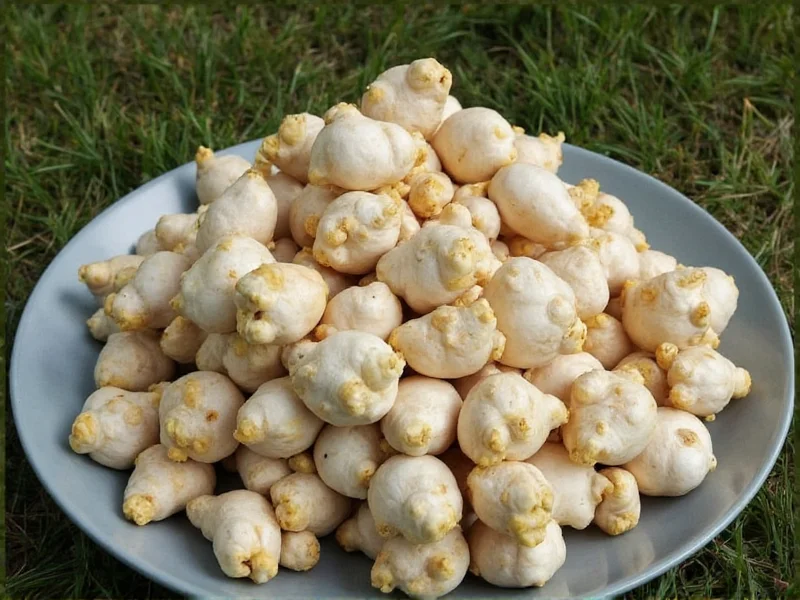When you're exploring what's galangal exactly, you're encountering one of Southeast Asia's most essential culinary ingredients. This knobby rhizome (Alpinia galanga) belongs to the Zingiberaceae family, sharing botanical roots with ginger and turmeric but offering a completely unique flavor experience. Fresh galangal features a pale pinkish-tan skin with smooth, firm flesh that ranges from ivory to light pink. Its aroma combines citrus, pine, and subtle floral notes with a peppery finish—distinctly different from ginger's warm spiciness.
Understanding Galangal: Beyond the Basics
Many home cooks confuse galangal with ginger due to their similar appearance, but they're not interchangeable. While ginger delivers a fiery warmth, galangal offers a more complex profile with lemony undertones and a clean, sharp finish. This difference becomes crucial when preparing authentic Thai, Indonesian, or Malaysian dishes where galangal's unique flavor is non-negotiable.
Types of Galangal You'll Encounter
Two primary varieties appear in Western markets:
| Type | Appearance | Flavor Profile | Common Uses |
|---|---|---|---|
| Greater Galangal | Longer, cylindrical shape; pale pink skin | Stronger citrus notes, sharper finish | Thai tom kha gai, Indonesian rendang |
| Lesser Galangal | Rounder, smaller; reddish-brown skin | Milder, more floral | Malaysian laksa, traditional medicines |
Galangal vs Ginger: Key Differences You Need to Know
Understanding the galangal vs ginger difference prevents recipe disasters. While both are rhizomes, they differ significantly:
- Texture: Galangal is much harder and woodier, often requiring grating or thin slicing
- Flavor intensity: Galangal's flavor remains stable during long cooking, while ginger mellows
- Culinary role: Ginger often provides background warmth; galangal delivers distinctive foreground flavor
- Substitution ratio: Using ginger for galangal requires adjusting quantities and expectations
How to Select and Store Galangal
When shopping for fresh galangal, look for firm, smooth rhizomes without wrinkles or soft spots. The skin should feel tight with minimal 'give' when pressed. For storage, wrap unpeeled galangal in paper towels inside a resealable bag in your refrigerator's crisper drawer—it keeps for 2-3 weeks. For longer storage, freeze whole or sliced pieces for up to 6 months without significant flavor loss.
Using Galangal in Your Cooking
Mastering how to use galangal in cooking transforms Southeast Asian dishes. Unlike ginger which can be minced finely, galangal's fibrous nature means it's typically sliced paper-thin or grated. In Thai cuisine, it's essential for tom kha gai (coconut soup) where its citrus notes balance the richness. In Indonesian cooking, it forms part of the 'bumbu' spice base for curries. Remember: galangal's flavor intensifies during cooking, so start with less than you think you need.
Finding Galangal and Suitable Substitutes
Locating galangal can be challenging depending on your location. Check Asian grocery stores (particularly Thai, Vietnamese, or Indonesian markets), well-stocked supermarkets with international sections, or online retailers specializing in ethnic ingredients. If you're searching where to buy galangal without success, consider these substitutes:
- Best substitute: Equal parts fresh ginger plus a squeeze of lime juice
- For dried recipes: 1/4 teaspoon ground galangal powder per tablespoon fresh
- For soup bases: Combination of ginger, lemon zest, and a pinch of black pepper
Evidence-Based Health Considerations
While traditional medicine attributes various benefits to galangal, current research shows promising but preliminary results. Studies indicate galangal contains compounds with potential anti-inflammatory properties, though more human trials are needed. Unlike ginger which has well-documented effects on nausea, galangal's health applications remain less studied. Always consult healthcare professionals before using galangal for medicinal purposes, especially if you have bleeding disorders or take blood thinners.
Common Questions About Galangal
Understanding what is galangal root often leads to practical questions about its culinary application. Many home cooks wonder whether frozen galangal maintains quality (it does, with minimal flavor loss), or how to properly prepare it for different dishes. The key is recognizing that galangal isn't just 'another ginger'—it brings a distinctive flavor profile that defines many Southeast Asian specialties.











 浙公网安备
33010002000092号
浙公网安备
33010002000092号 浙B2-20120091-4
浙B2-20120091-4